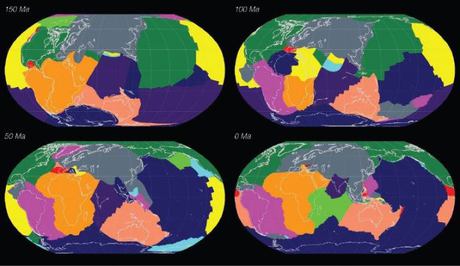Plate tectonics and pizza dough

The Earth’s crust has more in common with pizza dough than you might think, according to an international team looking into the mechanics of plate tectonics.
Continental drift and the incremental movement of the Earth’s surface has been fairly well understood for some time now, but one phenomenon that has been difficult to explain is the occasional lurch as continents uncouple.
It starts with millions of years of slow but relentless grinding and pulling, but when the supercontinent does eventually split, there is a full-margin rupture and rapid acceleration as the outer rims of the continents plunge into the gaping abyss.
Professor Dietmar Müller of the University of Sydney’s School of Geosciences explained: “Plates tend to shift around quite slowly because they’re sitting on an otherwise very viscous mantle. However, throughout Earth’s history, there have been plenty of instances where plates have suddenly sped up during supercontinent breakup.”
Professor Müller’s team has joined forces with the German Research Centre for Geosciences at the University of Potsdam to analyse the seismic data and develop sophisticated computer simulations to help explain this two-phase separation process.
Thousands of kilometres of seismic profiles had to be laboriously analysed to determine the exact areas where this vigorous stretching of the Earth’s mantle had taken place during continental separation. The subsequent big data analysis required high-performance computing in an open-innovation framework.
Professor Müller compares the results with the actions of your local pizzaiola: “Imagine you’re pulling apart a thick piece of dough. At first, separating it requires a lot of effort because the dough resists your pulling and stretches slowly between your hands. If you’re persistent, you’ll eventually reach a point where the dough becomes thin enough to separate quite easily and quickly. The same principle applies to rifting continents once the connection between them has been thinned sufficiently.”
According to lead author Dr Sascha Brune of the University of Potsdam: “This breakup process leads to margin segmentation, where rapid subsidence, high heat flow and enhanced volcanism characterise the outer margin.”
This research is part of the Basin Genesis Hub, a five-year project at the University of Sydney co-funded by industry and the Australian Research Council. Interactive models of the group’s work can be viewed at the Virtual Earth Laboratory.
Solar-powered reactor uses CO2 to make sustainable fuel
Researchers have developed a reactor that pulls carbon dioxide directly from the air and converts...
Scientists simulate the effects of an asteroid collision
How would our planet physically react to a future asteroid strike? Researchers simulated an...
2024 was warmest year on record, 1.55°C above pre-industrial level
The World Meteorological Organization says that 2024 was the warmest year on record, according to...




